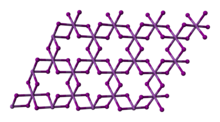
| |

| |

| |
| Names | |
|---|---|
| IUPAC name
Iron(III) bromide
| |
| Other names
Ferric bromide
Iron tribromide tribromoiron | |
| Identifiers | |
3D model (JSmol)
|
|
| ChemSpider | |
| ECHA InfoCard | 100.030.069 |
| EC Number |
|
PubChem CID
|
|
| UNII | |
CompTox Dashboard (EPA)
|
|
| |
| |
| Properties | |
| FeBr3 | |
| Molar mass | 295.56 g mol−1 |
| Appearance | brown solid |
| Odor | odorless |
| Density | 4.50 g cm−3 |
| Melting point | 200 °C (392 °F; 473 K) (decomposes) |
| Structure | |
| Trigonal, hR24 | |
| R-3, No. 148 | |
| Hazards | |
| Occupational safety and health (OHS/OSH): | |
Main hazards
|
corrosive |
| GHS labelling:[1] | |

| |
| Warning | |
| H315, H319, H335 | |
| NFPA 704 (fire diamond) | |
Except where otherwise noted, data are given for materials in their standard state (at 25 °C [77 °F], 100 kPa).
| |
Iron(III) bromide is the chemical compound with the formula FeBr3. Also known as ferric bromide, this red-brown odorless compound is used as a Lewis acid catalyst in the halogenation of aromatic compounds. It dissolves in water to give acidic solutions.
YouTube Encyclopedic
-
1/5Views:25 72410 89957 69025 12419 940
-
Writing Ionic Formulas With Transition Metals & Polyatomic Ions - Introduction - Chemistry
-
Chemical tests for Bromide - MeitY OLabs
-
Chemical Tests for Chloride - MeitY OLabs
-
Halides in solution: Test using acidified silver nitrate.
-
Chlorine Water Reacting with Iodide and Bromide
Transcription
Structure, synthesis and basic properties
FeBr3 forms a polymeric structure featuring six-coordinate, octahedral Fe centers.[2] Although inexpensively available commercially, FeBr3 can be prepared by treatment of iron metal with bromine:
- 2 Fe + 3 Br2 → 2 FeBr3
Above 200 °C, FeBr3 decomposes to ferrous bromide:
- 2FeBr3 → 2FeBr2 + Br2
Iron(III) chloride is considerably more stable, reflecting the greater oxidizing power of chlorine. FeI3 is not stable, as iron(III) will oxidize iodide ions.
Uses
Ferric bromide is occasionally used as an oxidant in organic chemistry, e.g. for the conversion of alcohols to ketones. It is used as a Lewis acidic catalyst for bromination of aromatic compounds. For the latter applications, it is often generated in situ.[3]
See also
- Iron(II) bromide, the lower bromide of iron
References
- ^ "C&L Inventory". echa.europa.eu.
- ^ Holleman, A. F.; Wiberg, E. "Inorganic Chemistry" Academic Press: San Diego, 2001. ISBN 0-12-352651-5.
- ^ Drapeau, Martin Pichette; Lafantaisie, Mathieu; Ollevier, Thierry (2013). "Iron(III) bromide". E-EROS Encyclopedia of Reagents for Organic Synthesis. doi:10.1002/047084289X.rn01568. ISBN 978-0471936237.

